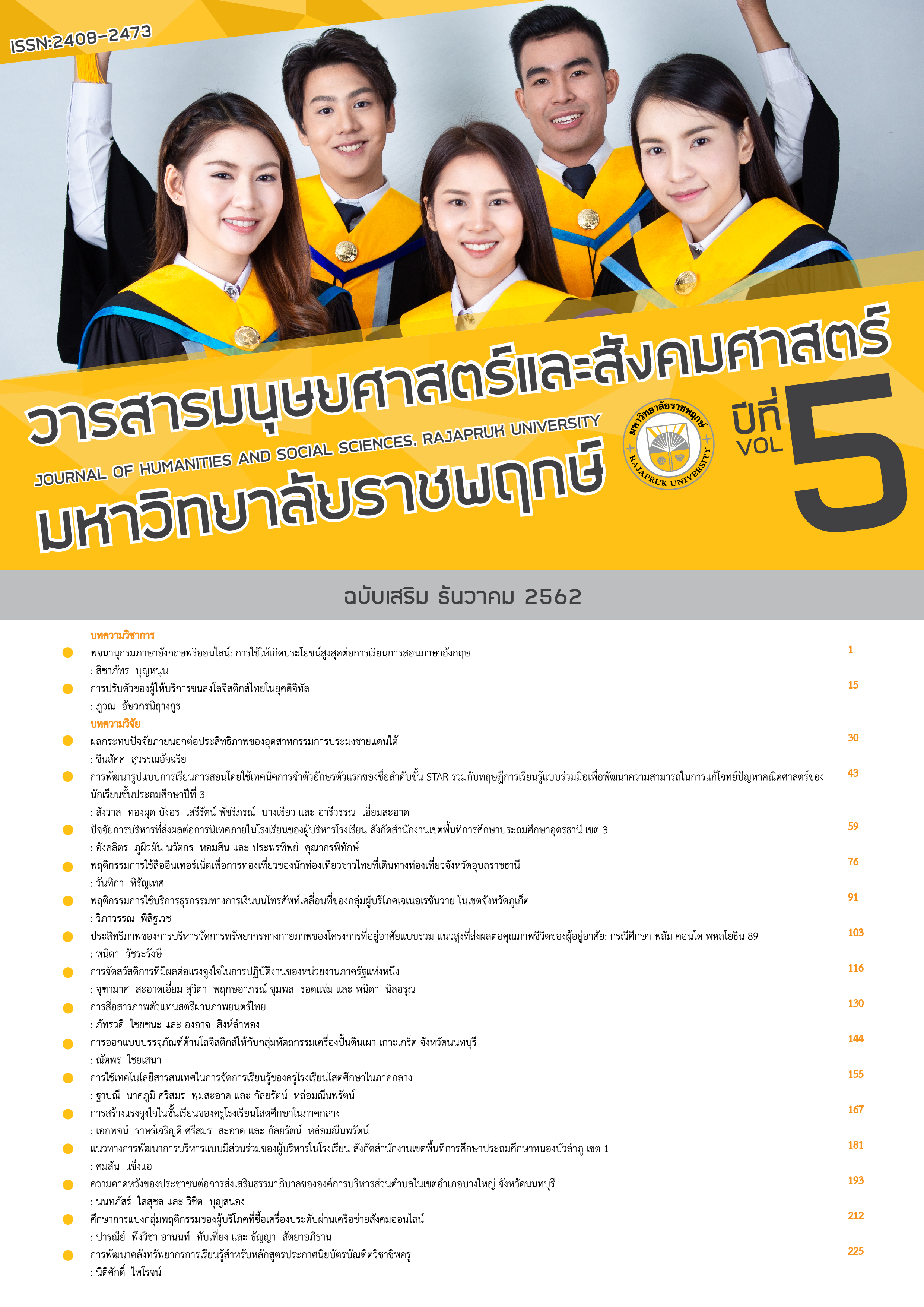The Use of Information Technology in Learning Management for Teachers of the Deaf Schools in The Central Region
Main Article Content
Abstract
This survey research aimed to examine; 1) the uses of information technology in learning management for secondary teachers of the Deaf Schools, 2) compare the use of information technology in learning management between lower secondary teachers and higher secondary teachers of the Deaf Schools, and 3) investigate the problems and limitation in using information technology in learning management for secondary teachers of the Deaf Schools. The sample group consisted of 33 Thai teachers; 19 of them teaching in lower secondary levels and the other 14 teaching in higher secondary levels at the Deaf Schools in the Central region. The research instruments included survey questionnaire and structured interview. The analysis was done by using frequency, percentage, mean and standard deviation as well as Mann-Whitney U for a comparison of information technology use.
The results showed that; 1) the uses of information technology in learning management for secondary teachers of the Deaf Schools for information searching, collecting, storing, developing work pieces and presenting were all in a high level. The teachers in both higher secondary levels and lower secondary levels used information technology for information searching and collecting the most; 2) the teachers in higher secondary levels appeared to use more information technology for all five purposes with statistical significance of .05, and 3) the problems and limitation in using information technology in learning management for secondary teachers of the Deaf Schools included (1) some teachers did not have enough computer knowledge and skills due to their age, lack of interest in technology, or lack of background knowledge in technology, (2) lack of resources; insufficient computer availability, and lack of Wi-Fi, (3) the communication problem and miscommunication between teachers and students particularly in using a sign language.
Article Details
References
ไพศาล จันทรังษี. (2561). การจัดการเทคโนโลยีดิจิทัลเพื่อสร้างความได้เปรียบในการแข่งขันของสถาบันอุดมศึกษาเอกชนในประเทศไทย. วารสารมนุษยศาสตร์และสังคมศาสตร์ มหาวิทยาลัยราชพฤกษ์, ครบรอบ 12 ปี: 22 - 27. ค้นเมื่อวันที่ 31 ธันวาคม 2561, จาก https://www.tci-thaijo.org/index.php/rpu/article/view/159603/115376.
ระบบสารสนเทศเพื่อการบริหารการศึกษา กลุ่มสารสนเทศ สำนักนโยบายและแผนการศึกษาขั้นพื้นฐาน สำนักงานคณะกรรมการการศึกษาขั้นพื้นฐาน. (2561). สำนักบริหารงานการศึกษาพิเศษ. ค้นเมื่อวันที่ 24 กันยายน 2561, จาก https://data.bopp-obec.info/emis/
วลัยรัตน์ โตวิกกัย. (2555). บทบาทของเทคโนโลยีสารสนเทศต่อการศึกษา. ค้นเมื่อวันที่ 23 มิถุนายน2555, https://www.gotoknow.org/posts/242734
วีรวุฒิ พึ่งเจริญ. (2551). องค์ประกอบที่สัมพันธ์กับการยอมรับนวัตกรรมทางเทคโนโลยีการศึกษา. วิทยานิพนธ์ครุศาสตร์มหาบัณฑิต สาขาวิชาโสตทัศนศึกษา ภาควิชาโสตทัศนศึกษา บัณฑิตวิทยาลัย จุฬาลงกรณ์มหาวิทยาลัย.
สุชาดา กีระนันท์. (2551). เทคโนโลยีสถิติ: ข้อมูลในระบบสารสนเทศ. กรุงเทพฯ: จุฬาลงกรณ์มหาวิทยาลัย.
สุภัทรี ศรีนอก. (2552). การพัฒนาบทเรียนคอมพิวเตอร์มัลติมีเดียเรื่องคำศัพท์ภาษาอังกฤษพื้นฐานที่ใช้ในชีวิตประจำวันสำหรับนักเรียนที่มีความบกพร่องทางการได้ยินช่วงชั้นที่ 2. สารนิพนธ์ การศึกษามหาบัณฑิต (เทคโนโลยีการศึกษา) บัณฑิตวิทยาลัย มหาวิทยาลัยศรีนครินทรวิโรฒ.
Education Management Information System, Information Subdivision, Policy and Basic Education Plan Office, Office of the Basic Education Commission. (2018). Office of Special Education Administration. Retrieved on 24th September 2018, from https://data.bopp-obec.info/emis/ (in Thai)
Jantarungsri, P. (2018). Digital Technology Management for Competitive Advantage among Private Higher Education Institutions in Thailand. Journal of Humanities and Social Sciences, Rajapruk University. 4 No supplement, 22 - 36. Retrieved on 31th December 2018, from https://www.tci-thaijo.org/index.php/rpu/article/view/159603/115376. (in Thai)
Keeranan, S. (2008). Information Technology Statistics: Information in the information system. Bangkok: Chulalongkorn University. (in Thai)
Phungcharoen, W. (2008). Factors related to the adoption of innovation in educational technology. Master of Education Thesis in Audiovisual Studies Department of Audiovisual Graduate School Chulalongkorn University. (in Thai)
Sinlarat, P. (2015). The role of teachers in the future: Prepare students to continue teaching themselves. Journal of Humanities and Social Sciences, Rajapruk University, 1(1), 1-8. Retrieved from https://www.tci- thaijo.org/index.php/
rpu/article/ view/112118. (in Thai)
Srinok, S. (2009). The Development of a computer Multimedia Instruction on Basic English Vocabulary for Hearing Impaired Level 2 Students. M.Ed. (Educational Technology). Graduate School, Srinakharinwirot University. (in Thai)
Towikkay, W. (2012). Role of Information Technology in education. Retrieved on 23th June 2012, from https://www.gotoknow.org/posts/242734 (in Thai)


